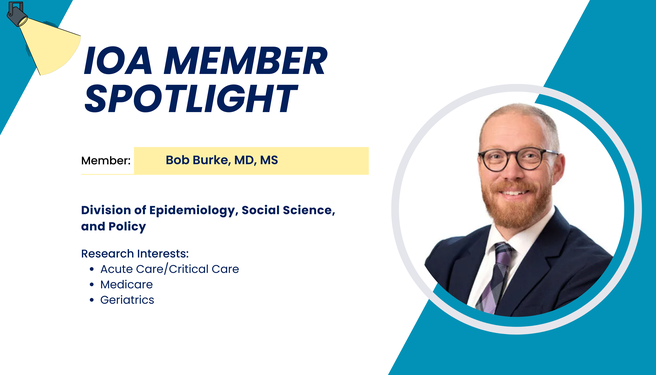
Bob Burke, MD, MS
Associate Professor, Medicine, Perelman School of Medicine
Biography
Robert Burke, MD, MS, is the Associate Chief for Research in the Division of General Internal Medicine and the Division of Hospital Medicine at Penn, and a tenured Associate Professor of Medicine. His research focuses on reducing unnecessary hospitalizations and long-term nursing home care for frail older adults. He leads the VA’s SAGE QUERI implementation science center, which advances evidence-based practices aligned with the Age-Friendly Health System model. His work also addresses health policy and payment reform, supported by R01-level funding from the National Institutes of Health, the Agency for Healthcare Research and Quality, and the Department of Veterans Affairs.
Q&A
Q: What motivated you to focus specifically on aging-related care in your research?
A: “As a hospitalist physician, I witness how the inadequacies of our health and social systems regularly lead to hospitalization. In particular, hospitalization is often a sentinel event in the lives of older adults. Older adults and their families are often grappling with new realities of needing more assistance at home or a diagnosis that will change their trajectory permanently. I also see older adults who are admitted to the hospital simply because their home environment and supports aren’t working anymore, caregivers who are exhausted, or they haven’t been able to access our patchwork system of long-term supports successfully. These experiences were so motivating because they revealed first how ignorant I was of how our patchwork “system” of post-acute and long-term care works, and how poorly this system functioned for most older adults.”
Q: What are the main goals you hope to achieve with your work?
A: “I hope to better align payments and policies - which drive the care and options available to older adults - to help support older adults' ability to stay out of the hospital and out of long-term nursing homes if that is consistent with their goals. I study particularly high-risk times in their care trajectory (such as hospitalization and the post-hospital period) since this is often a precipitating event leading to long-term nursing home care. For example, I recently evaluated the largest pay-for-performance program ever tested to improve care in skilled nursing facilities, which are common places for older adults to go to after hospitalization to rehabilitate and recuperate. We found the program was not successful in improving care and were able to observe some potential reasons why that could be changed in future policy.”
Q: What are some of the biggest challenges that you face in this line of work?
A: “Creating meaningful change means not just conducting rigorous research, but also convincing legislators and policymakers about how to operationalize those findings. In addition, no single entity is in charge of our long-term care system currently - it’s a mashup of providers, payers, and systems of care, making it difficult to effectively advocate.”
Q: What’s next for you in terms of future projects or research directions?
A: “I’ve taken on a new role as the Medical Director of Penn’s nascent Hospital at Home program, and am excited to explore how this model of home-based care could be used to strengthen our ability to help older adults remain in their homes as they age. I’m also working on projects across Penn and the VA to study new policies and implement new care delivery models that could help support older adults as well.”
Recent Achievements
- Dr. Burke was the recipient of his Division’s Excellence in Professional Development and Mentorship Award in 2024. He hopes to expand his capabilities as a mentor through a National Institute on Aging-funded K24 award, which recently received a fundable score.
Recent Publications
- Skilled Nursing Facility Value-Based Purchasing Failed To Achieve Hospital Readmission Reductions And Other Targets
- Size of the Financial Incentives in Medicare's Skilled Nursing Facility Value-Based Purchasing Program
- Evaluating the relationship between facility Age-Friendly recognition and subsequent facility-free days in older Veterans

